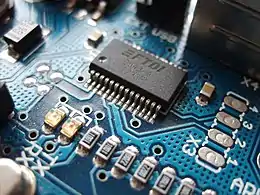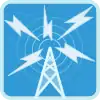Portal:Electronics
The Electronics Portal Modern surface-mount electronic components on a printed circuit board, with a large integrated circuit at the top. The field of electronics is a branch of physics and electrical engineering that deals with the emission, behaviour and effects of electrons using electronic devices. Electronics uses active devices to control electron flow by amplification and rectification, which distinguishes it from classical electrical engineering, which only uses passive effects such as resistance, capacitance and inductance to control electric current flow. Electronics has hugely influenced the development of modern society. The central driving force behind the entire electronics industry is the semiconductor industry sector, which has annual sales of over $481 billion as of 2018. The largest industry sector is e-commerce, which generated over $29 trillion in 2017. (Full article...)
|
|
|
Main topics
Electronics - Consumer electronics - Engineering - Manufacturing - Symbols - Units - Waste
Theory: Ampère's law - Coulomb's law - Frequency - Hall effect - Joule's laws - Kirchhoff's laws - Millman's Theorem - Moore's Law - Norton's theorem - Ohm's law - Peukert's law - Resistance - Thévenin's theorem- Superposition - Wavelength
Components: Antenna - Capacitor - Connectors - Diode - Fuse - Ground - Inductor - Integrated circuit - LCD - Magnetron - Memristor - Phased array - Printed circuit board - Resistor - Thermocouple - Transformer - Transistor - Switch - Wire
Circuits: AC - Bridge - Designs - Diagrams - DC - Impedance - Load - Series and parallel - Voltage divider - Voltage drop
Fields: Avionics - Computer systems - Control systems - Electromechanics - Microelectronics - Optoelectronics - Power - Quantum electronics - Radio - Robotics - Semiconductors - Spintronics - Telecommunications
Products: Cameras - Computers - Fiber optics - Lasers - Lights - Mobile phones - Printed circuit board - Radios - TVs
Companies: AMD - Apple - Bose - Canon - Cray - Dell - Fujitsu - Garmin - HP - IBM - Intel - JVC - Kyocera - LG - Microsoft - Motorola - NEC - Nintendo - Philips - Pioneer - RadioShack - Samsung - Siemens - Sirius - Sony - Texas Instruments - Xerox
People: Ampère - Becquerel - Bell - Coulomb - Edison - Einstein - Faraday - Gauss - Geiger - Hall - Henry - Hertz - Joule - Kirchhoff - Marconi - Moore - Ohm - Ørsted - Planck - Siemens - Tesla - Volta - Watt - Weber
Subcategories
Associated Wikimedia
The following Wikimedia Foundation sister projects provide more on this subject:
-
 Commons
Commons
Free media repository -
 Wikibooks
Wikibooks
Free textbooks and manuals -
 Wikidata
Wikidata
Free knowledge base -
 Wikinews
Wikinews
Free-content news -
 Wikiquote
Wikiquote
Collection of quotations -
 Wikisource
Wikisource
Free-content library -
 Wikiversity
Wikiversity
Free learning tools -
 Wiktionary
Wiktionary
Dictionary and thesaurus
-
 List of all portalsList of all portals
List of all portalsList of all portals -
 The arts portal
The arts portal -
 Biography portal
Biography portal -
 Current events portal
Current events portal -
 Geography portal
Geography portal -
 History portal
History portal -
 Mathematics portal
Mathematics portal -
 Science portal
Science portal -
 Society portal
Society portal -
 Technology portal
Technology portal -
 Random portalRandom portal
Random portalRandom portal -
 WikiProject PortalsWikiProject Portals
WikiProject PortalsWikiProject Portals



_in_a_domestic_setting.jpg.webp)










